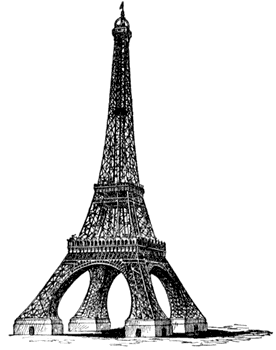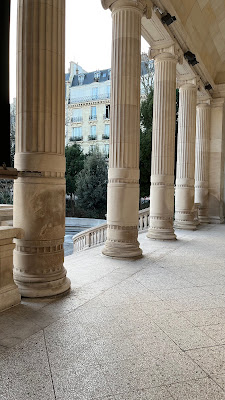The museum Louis Vuitton Foundation opened in 2014 in the Bois de Boulonge in a building designed by the architect Frank Gehry. I ventured out last week to see the special exhibit “The Morozov Collection: Icons of Modern Art.”
 |
| Morozov Collection |
 |
| Fondation Louis Vuitton |
 |
Le Frank Café
with Flying Fish |
The Russian brothers Mikhail and Ivan Morozov created one of the world’s strongest collections of Impressionist and Modern Art beginning in the 1890s. The brothers were born in 1870 and 1871 into a family of industrialists who owned several textile factories.
 |
| Ivan Morozov by Konstantine Korovine 1903 |
 |
Mikhail Morozov
by Valentin Serov 1902 |
Their great-grandfather, Savva, was a serf. With five rubles from his wife’s dowry, Savva set up a ribbon workshop, which developed into a factory, and he bought his family’s freedom. In a few generations the family became wealthy, philanthropic industrialists. Mikhail and Ivan’s mother gave them a thorough artistic education and they loved the theater, literature and painting. They also spoke French like most of the aristocratic class in Russia.
 |
Mika Morozov by Valentin Serov 1901
Mikhail’s son |
At the end of the 19th century, Russian cultural life began to open up and be more modern and Mikhail started collecting art with the help of advisors such as the Russian painters Konstantine Korovine and Valentin Serov. He collected impressionist paintings, landscapes, scenes of Parisian life and also nudes, which were then badly perceived because of the puritanical environment in Russia.
 |
|
 |
|
Above are two portraits of the French actress Jeanne Samary by Jean-Auguste Renoir. He painted the one on the left in 1877 but it was not well received by critics at the Impressionist Exhibition. So he did the full length portrait in 1878 in a more classical style. I especially love the colors in the first portrait.
Mikhail collected Manet, Corot, Monet, Toulouse-Lautrec, Degas, Bonnard, Denis, Gauguin and Van Gogh. Tragically, he died at the age of 33 in 1903. His collection included 39 French and 44 Russian works when he died and his brother Ivan took over the project of collecting.
 |
| Mikhail’s Family after his Death |
Mikhail discovered Pierre Bonnard’s work in Paris and he acquired the first paintings by Gauguin to enter Russia. Bonnard was known for his bold use of color.
 |
| Morning in Paris by Bonnard |
 |
| Evening in Paris by Bonnard |
 |
| Café at Arles by Gauguin |
The brothers stood out for their unconditional patronage of contemporary European and Russian art, which contributed to enhancing the international reputation of modern French painters.
 |
Poppy Fields by Monet
|
I loved these two Paris scenes on Île de la Cité from 1910. Life looks calmer somehow.
 |
Rainy Day, Notre Dame de Paris
by Albert Marquet |
 |
View of the Seine and the Monument to Henri IV
by Albert Marquet |
Ivan Morozov adored the work of Paul Cézanne. Having tried their hand at landscape painting in their youth, the brothers felt an affinity for the landscapes and acquired 18 works by Cézanne. However, it looks like I didn't take pictures of any of his landscapes.
 |
| Smoker by Paul Cézanne |
Mikhail bought Vincent Van Gogh’s Seascape at Saintes-Maries in 1901. It was probably the first Van Gogh painting in Russia. I love the churning blue and yellow waters and thickly applied paint against the red boats.
 |
| Seascape at Saintes-Maries by Van Gogh |
The other Van Gogh painting at the exhibit was haunting. I had never seen or heard of it before. For months, Van Gogh tried to leave the Saint-Rémy-de-Provence psychiatric asylum where he had voluntarily committed himself. This is where Van Gogh painted The Prison Courtyard in 1890.
 |
The Prison Courtyard by Van Gogh
|
Van Gogh's brother had sent him a photograph of Gustave Doré’s drawing “Newgate-Exercise Yard” which shows a line of prisoners in the courtyard of a notorious London prison. Deprived of his walks through the countryside, without models and with little paper, canvas or color, Van Gogh spent his time copying or “interpreting” photographs and black and white engravings. He reinterpreted the London prison to show the confinement he suffered, with the lonely outcasts that surrounded him. The man in the center of the circle with the dangling arms, the only one to look at the viewer, is Van Gogh.
I watched a woman copying an André Derain painting.
 |
| Drying the Sails by Derain |
As Ivan acquired paintings from Paris, they were made available to Russian artists to see and study. I could see the influence of Cézanne and Picasso on them, including this self-portrait by Ilia Machkov painted in 1911. Machkov’s bowl of fruit is also influenced by Cézanne and evokes the painted signs of the greengrocers and grocery stores of rural Russia.
 |
Harlequin and His Companion
by Picasso |
 |
Portrait of Ambroise Vollard
by Picasso |
 |
| Self Portrait by Ilia Machkov |
 |
| Still Life, Fruit in a Dish by Machkov |
 |
| Still Life with a Curtain by Cézanne |
Machkov’s self portrait and portrait of the artist Piotr Kontchalovski was really interesting. It is the manifesto of Russian “Cézannism.” The painters are wearing wrestling shorts and shoes, showing their muscles and scowling looks. This refers to the legend that the cubists Pablo Picasso and Georges Braque loved boxing. But instead of being in a boxing ring, they are in a small middle class living room. Above the piano are books with the titles Cézanne, Arts, Egypt-Greece-Italy and the Bible, representing “an artistic program where antique, biblical and classical arts are synthesized in a post-Cézanne modernity. The rarified atmosphere of provincial life, filled with connections, rules and customs, where everyone is secluded and at the same time fully exposed, known and judged, is the painting's subject.” Wow. That's heavy.
 |
Machkov and Kontchalovski
|
There were a variety of Henri Matisse paintings beginning early in his career.
 |
| Blue Jug by Matisse, 1898 |
 |
| Still Life with The Dance by Matisse, 1909 |
 |
| Fruit and Bronze by Matisse, 1910 |
The Russian artist Valentin Serov painted Ivan Morozov with his Matisse painting in the background in 1910.
 |
Portrait of Ivan Abramovich Morozov by Serov
|
In 1918, the Morozovs’ collection included 240 French works of art and 430 Russian works. In 1918 during the Russian revolution, a decree by Lenin confiscated and nationalized the Morozovs’ collection. Some so-called “degenerate” paintings were hidden in Siberia to escape destruction.
 |
| Pictures of Ivan Morozov’s home |
After the art collection was nationalized in 1918, Ivan Morozov fled to Finland and died in Karlsbad, Germany, at the age of 49. The collection formed part of the Russian Museum of Modern Western Art, which Stalin ordered to be closed in 1948. The Morozov collection and the rest of the contents of this museum were divided between the Pushkin Museum of Fine Arts and the Tretyakov Gallery in Moscow, and the Hermitage Museum in Saint Petersburg. The Soviet state sold several works for economic reasons, including Van Gogh’s Café de Nuit (now in the Yale University collection) and Cézanne’s portrait of Madame Cézanne (now in New York’s Metropolitan Museum). “But things could have been worse. Stalin hated Western art and could have asked for its destruction.”
The showing of over 200 works of art from the Morozov collection outside Russia for the first time is a major event, achieved partly thanks to the Louis Vuitton Foundation helping the Russian museums restore works by some of the artists and being involved in organizing the Morozov exhibition at the Hermitage in 2019. It was an amazing exhibition.












































































